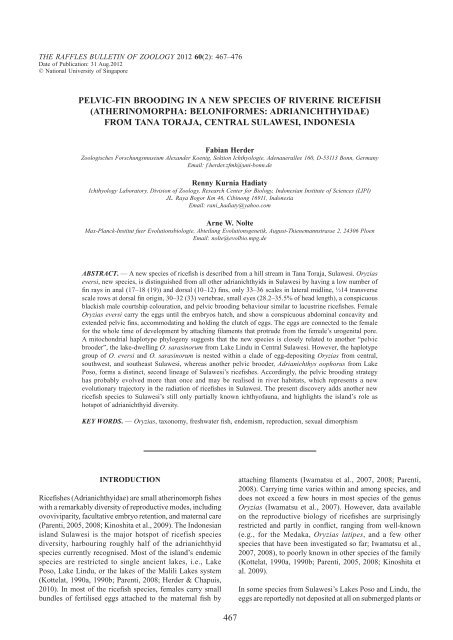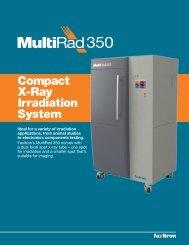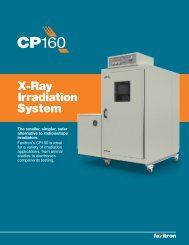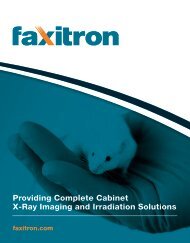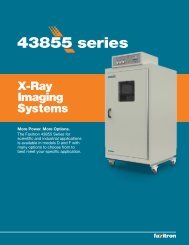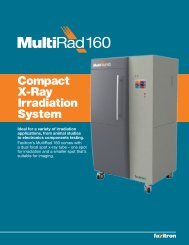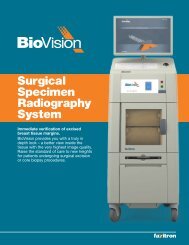Pelvic-Fin Brooding In a New Species of Riverine Ricefish - Raffles ...
Pelvic-Fin Brooding In a New Species of Riverine Ricefish - Raffles ...
Pelvic-Fin Brooding In a New Species of Riverine Ricefish - Raffles ...
You also want an ePaper? Increase the reach of your titles
YUMPU automatically turns print PDFs into web optimized ePapers that Google loves.
THE RAFFLES BULLETIN OF ZOOLOGY 2012<br />
THE RAFFLES BULLETIN OF ZOOLOGY 2012 60(2): 467–476<br />
Date <strong>of</strong> Publication: 31 Aug.2012<br />
© National University <strong>of</strong> Singapore<br />
PELVIC-FIN BROODING IN A NEW SPECIES OF RIVERINE RICEFISH<br />
(ATHERINOMORPHA: BELONIFORMES: ADRIANICHTHYIDAE)<br />
FROM TANA TORAJA, CENTRAL SULAWESI, INDONESIA<br />
Fabian Herder<br />
Zoologisches Forschungsmuseum Alexander Koenig, Sektion Ichthyologie, Adenauerallee 160, D-53113 Bonn, Germany<br />
Email: f.herder.zfmk@uni-bonn.de<br />
Renny Kurnia Hadiaty<br />
Ichthyology Laboratory, Division <strong>of</strong> Zoology, Research Center for Biology, <strong>In</strong>donesian <strong>In</strong>stitute <strong>of</strong> Sciences (LIPI)<br />
JL. Raya Bogor Km 46, Cibinong 16911, <strong>In</strong>donesia<br />
Email: rani_hadiaty@yahoo.com<br />
Arne W. Nolte<br />
Max-Planck-<strong>In</strong>stitut fuer Evolutionsbiologie, Abteilung Evolutionsgenetik, August-Thienemannstrasse 2, 24306 Ploen<br />
Email: nolte@evolbio.mpg.de<br />
ABSTRACT. — A new species <strong>of</strong> ricefish is described from a hill stream in Tana Toraja, Sulawesi. Oryzias<br />
eversi, new species, is distinguished from all other adrianichthyids in Sulawesi by having a low number <strong>of</strong><br />
fin rays in anal (17–18 (19)) and dorsal (10–12) fins, only 33–36 scales in lateral midline, ½14 transverse<br />
scale rows at dorsal fin origin, 30–32 (33) vertebrae, small eyes (28.2–35.5% <strong>of</strong> head length), a conspicuous<br />
blackish male courtship colouration, and pelvic brooding behaviour similar to lacustrine ricefishes. Female<br />
Oryzias eversi carry the eggs until the embryos hatch, and show a conspicuous abdominal concavity and<br />
extended pelvic fins, accommodating and holding the clutch <strong>of</strong> eggs. The eggs are connected to the female<br />
for the whole time <strong>of</strong> development by attaching filaments that protrude from the female’s urogenital pore.<br />
A mitochondrial haplotype phylogeny suggests that the new species is closely related to another “pelvic<br />
brooder”, the lake-dwelling O. sarasinorum from Lake Lindu in Central Sulawesi. However, the haplotype<br />
group <strong>of</strong> O. eversi and O. sarasinorum is nested within a clade <strong>of</strong> egg-depositing Oryzias from central,<br />
southwest, and southeast Sulawesi, whereas another pelvic brooder, Adrianichthys oophorus from Lake<br />
Poso, forms a distinct, second lineage <strong>of</strong> Sulawesi’s ricefishes. Accordingly, the pelvic brooding strategy<br />
has probably evolved more than once and may be realised in river habitats, which represents a new<br />
evolutionary trajectory in the radiation <strong>of</strong> ricefishes in Sulawesi. The present discovery adds another new<br />
ricefish species to Sulawesi’s still only partially known ichthy<strong>of</strong>auna, and highlights the island’s role as<br />
hotspot <strong>of</strong> adrianichthyid diversity.<br />
KEY WORDS. — Oryzias, taxonomy, freshwater fish, endemism, reproduction, sexual dimorphism<br />
INTRODUCTION<br />
<strong>Ricefish</strong>es (Adrianichthyidae) are small atherinomorph fishes<br />
with a remarkably diversity <strong>of</strong> reproductive modes, including<br />
ovoviviparity, facultative embryo retention, and maternal care<br />
(Parenti, 2005, 2008; Kinoshita et al., 2009). The <strong>In</strong>donesian<br />
island Sulawesi is the major hotspot <strong>of</strong> ricefish species<br />
diversity, harbouring roughly half <strong>of</strong> the adrianichthyid<br />
species currently recognised. Most <strong>of</strong> the island’s endemic<br />
species are restricted to single ancient lakes, i.e., Lake<br />
Poso, Lake Lindu, or the lakes <strong>of</strong> the Malili Lakes system<br />
(Kottelat, 1990a, 1990b; Parenti, 2008; Herder & Chapuis,<br />
2010). <strong>In</strong> most <strong>of</strong> the ricefish species, females carry small<br />
bundles <strong>of</strong> fertilised eggs attached to the maternal fish by<br />
attaching filaments (Iwamatsu et al., 2007, 2008; Parenti,<br />
2008). Carrying time varies within and among species, and<br />
does not exceed a few hours in most species <strong>of</strong> the genus<br />
Oryzias (Iwamatsu et al., 2007). However, data available<br />
on the reproductive biology <strong>of</strong> ricefishes are surprisingly<br />
restricted and partly in conflict, ranging from well-known<br />
(e.g., for the Medaka, Oryzias latipes, and a few other<br />
species that have been investigated so far; Iwamatsu et al.,<br />
2007, 2008), to poorly known in other species <strong>of</strong> the family<br />
(Kottelat, 1990a, 1990b; Parenti, 2005, 2008; Kinoshita et<br />
al. 2009).<br />
<strong>In</strong> some species from Sulawesi’s Lakes Poso and Lindu, the<br />
eggs are reportedly not deposited at all on submerged plants or<br />
467
Herder et al: A new pelvic brooding ricefish from Sulawesi<br />
other material, but kept by the female until hatching (Kottelat,<br />
1990a). At least two <strong>of</strong> these species, Adrianichthys oophorus<br />
from Lake Poso and Oryzias sarasinorum from Lake Lindu,<br />
show clear adaptations for “pelvic brooding” (i.e., females<br />
have extended pelvic fins, covering the clutch <strong>of</strong> eggs kept in a<br />
more or less well developed abdominal concavity, attached to<br />
the female by attaching filaments; Kottelat, 1990a; Iwamatsu<br />
et al., 2007, 2008; Parenti, 2008). As pelvic brooders do not<br />
depend on substrate for completing their reproductive cycle,<br />
this strategy has been considered as a potential adaptation to<br />
a predominantly pelagic life style in lake habitats (Kottelat,<br />
1990a; Parenti, 2008). <strong>In</strong> O. sarasinorum, the attaching<br />
filaments form a “plug” with epithelial cells at the female’s<br />
urogenital pore, and there are indications that the developing<br />
embryos affect physiological pathways regulating the<br />
female’s reproductive physiology (Iwamatsu et al., 2007,<br />
2008); even the possibility <strong>of</strong> a placental function has been<br />
considered (Iwamatsu et al., 2008).<br />
Since Parenti’s comprehensive revision <strong>of</strong> ricefishes in 2008,<br />
additional species <strong>of</strong> Oryzias have been uncovered from<br />
lake and stream habitats in Sulawesi (Herder & Chapuis,<br />
2010; Parenti & Hadiaty, 2010; Parenti et al., in prep.). Here<br />
we describe a new pelvic brooding ricefish species from a<br />
forest stream habitat in Tana Toraja (Central Sulawesi, South<br />
Sulawesi Province), the first record <strong>of</strong> this reproductive<br />
strategy (or reproductive guild sensu Kottelat, 1990a) in a<br />
stream habitat. As this discovery raises questions concerning<br />
the origin and evolutionary ecology <strong>of</strong> pelvic brooding, we<br />
present a mitochondrial haplotype phylogeny <strong>of</strong> Sulawesi’s<br />
ricefishes and discuss the evolutionary origins <strong>of</strong> pelvic<br />
brooding. The present results provide further support for<br />
the still “under-described” (Roberts, 1998: 213) status <strong>of</strong><br />
ricefishes, also highlighted by the recent discovery <strong>of</strong> new<br />
species from other Asian regions (Magtoon, 2010; Asai et<br />
al., 2011), and further emphasize our incomplete knowledge<br />
<strong>of</strong> the freshwater ichthy<strong>of</strong>auna <strong>of</strong> Sulawesi.<br />
MATERIAL AND METHODS<br />
Analyses <strong>of</strong> morphology and reproductive behaviour. —<br />
Specimens <strong>of</strong> the new Oryzias were obtained from a tributary<br />
<strong>of</strong> Salo Sadang (3°02.126S, 119°53.232E) about 8 km south<br />
<strong>of</strong> Rantepao, Tana Toraja, Central Sulawesi, <strong>In</strong>donesia, in<br />
24 Sep.2010. Fish were caught by snorkeling using hand<br />
nets. Single individuals <strong>of</strong> both sexes were photographed<br />
immediately after capture to document life colouration; a stock<br />
<strong>of</strong> living individuals was kept alive in aquaria to investigate<br />
reproductive biology, life colouration, and behaviour.<br />
The habitat characterisation is based on photographs and<br />
descriptions by H.-G. Evers (pers. comm.). Specimens for<br />
morphological examination were either preserved directly in<br />
70% ethanol, or were kept for observations in the aquarium<br />
and were subsequently preserved in 4% formalin and later<br />
transferred to 70% ethanol for storage. Material examined is<br />
deposited in the Research Centre for Biology, the <strong>In</strong>donesian<br />
<strong>In</strong>stitute <strong>of</strong> Sciences (LIPI, formerly the Museum Zoologicum<br />
Bogoriense – MZB), Cibinong, <strong>In</strong>donesia, the Zoologisches<br />
Forschungsmuseum Alexander Koenig, Bonn (ZFMK),<br />
Germany, and the National Museum <strong>of</strong> Natural History,<br />
Smithsonian <strong>In</strong>stitution, Washington, DC (USNM), United<br />
States <strong>of</strong> America. Morphometric measurements and meristics<br />
follow Kottelat (1990b) and Parenti & Soeroto (2004). All<br />
measurements are taken from point to point, recorded to<br />
the nearest 0.1 mm with a digital caliper. Abbreviations<br />
used are SL – standard length, HL – head length. Counts <strong>of</strong><br />
the unpaired fins and vertebrae (total = precaudal + caudal)<br />
were made from radiographs, using a digital X-ray device<br />
(Faxitron LX-60). Dorsal- and anal fin ray counts are reported<br />
in total, including the single first unbranched and a number<br />
<strong>of</strong> branched rays. Principal and procurrent caudal fin ray<br />
numbers are reported following Rosen & Parenti (1981) and<br />
Parenti (2008). For example, i,4/5,i, stands for one principal<br />
unbranched and four branched rays in the dorsal lobe and<br />
five branched and one principal unbranched ray in the ventral<br />
lobe, and 6/7 stands for six procurrent rays in the dorsal and<br />
seven procurrent rays in the ventral lobe. Scale counts follow<br />
Kottelat (1990b); the small scales on caudal fin base are not<br />
included. Scales in transverse row are counted from origin <strong>of</strong><br />
dorsal fin to lateral row and continuing to anal fin origin; ½<br />
refers to the scale in front <strong>of</strong> the dorsal fin. Meristic values<br />
in brackets are deviations from the type series present in 4<br />
additional immature specimens examined.<br />
Phylogenetic analyses. — Complementary to ricefish<br />
sequence data available from Takehana et al. (2005), a 16s<br />
rDNA fragment was sequenced using the primers L2606 5'-<br />
TTGACCGTGCAAAGGTAGCGCAATCACT-3' and H3056<br />
5'-CTCCGGTCTGAACTCAGATCACGTAGG-3' from the<br />
same authors for Oryzias eversi and additional adrianichthyids<br />
from Sulawesi (Appendix 1). DNA was extracted using<br />
DNeasy Blood & Tissue Kit (Quiagen) and PCR amplified<br />
using the Quagen Multiplex PCR Kit following the protocols<br />
supplied by the provider. The following PCR program was<br />
used: 15 min at 95°C, 36 cycles <strong>of</strong> (30 s at 94°C, 90 s at 68°C,<br />
90 s at 72°C) and a final extension <strong>of</strong> 10 min at 72°C. Products<br />
for sequencing were prepared for sequencing using an exosap<br />
protocol and sanger-sequenced in both directions on an<br />
ABI 3130xl Genetic Analyser. Sequences <strong>of</strong> representative<br />
adrianichthyid taxa from outside <strong>of</strong> Sulawesi and additional<br />
sequence data available for Sulawesi ricefishes were retrieved<br />
from genbank (http://www.ncbi.nlm.nih.gov/genbank/; see<br />
Appendix 1). All sequences were aligned using BioEdit (Hall,<br />
1999) and electropherograms and alignments were checked<br />
by eye and edited after combining the data with reference<br />
sequences from GenBank. The final data was trimmed to<br />
477 bp. We used MrModeltest (Nylander, 2004) to infer the<br />
most likely model <strong>of</strong> sequence evolution and used MrBayes<br />
(Ronquist et al., in press) to infer a bayesian phylogeny and<br />
posterior probabilities <strong>of</strong> the branching patterns.<br />
TAXONOMY<br />
Oryzias eversi, new species<br />
(English common name: Evers’ ricefish)<br />
(Figs. 1–3)<br />
Material examined. — Holotype – MZB 20780 (35.8 mm SL), male,<br />
<strong>In</strong>donesia, Sulawesi: South Sulawesi Province, Tana Toraja; Salo<br />
468
THE RAFFLES BULLETIN OF ZOOLOGY 2012<br />
Sadang drainage, stream close by the village Tilanga, about 8 km<br />
S <strong>of</strong> Rantepao; 3°02.126S, 119°53.232E, elev. 859 m; coll. H.-G.<br />
Evers, J. Christian, P. Debold, T. Heinrich, 24 Sep.2010.<br />
Paratypes – All collected with the holotype: MZB 20781, 1 female<br />
(28.0 mm SL), ZFMK 44938, 1 male (36.2 mm SL), ZFMK 44939,<br />
1 female (34.9 mm SL), USNM 406817, 1 male (33.5 mm SL),<br />
USNM 406818, 1 female (38.4 mm SL).<br />
Non-type material – ZFMK 44940-44943, 4 immature specimens<br />
(16.8–21.6 mm SL), collected with the holotype.<br />
Diagnosis. — Oryzias eversi is distinguished from all other<br />
Adrianichthyidae in Sulawesi by the following combination<br />
<strong>of</strong> characters: 17–18 (19) fin rays in the anal fin; 10–12 fin<br />
rays in the dorsal fin; 33–36 scales along lateral midline; ½14<br />
transverse scale rows at dorsal fin origin; 30–32 (33) total<br />
vertebrae; small eye size relative to head length (28.2–35.5%<br />
HL); absence <strong>of</strong> dark bluish or steel blue body colouration<br />
or brilliant red marks in both sexes; conspicuous blackish<br />
courtship colouration <strong>of</strong> males, including a blackish belly<br />
and posterior lateral body, presence <strong>of</strong> 6–9 blackish lateral<br />
bars, and presence <strong>of</strong> a narrow black line on a light brown<br />
background on dorsal surface; i,4/5,i principal caudal fin rays;<br />
and a conspicuous pelvic brooding behaviour associated with<br />
sexually dimorphic body depth and pelvic fin length.<br />
Description. — See Fig. 3 for general appearance in<br />
lateral view, Fig. 2 for radiographs <strong>of</strong> male holotype and a<br />
female paratype, and Table 1 for morphometric data. Body<br />
compressed laterally, slender to somewhat deep-bodied,<br />
body depth 18.9–24.6% SL. Females with a pronounced<br />
abdominal concavity between pelvic fins and anal fin, covered<br />
by long (18.9–19.6% SL) pelvic fins. Mouth terminal, lower<br />
jaw extends slightly beyond upper jaw. No external teeth.<br />
Ventral body pr<strong>of</strong>ile arching from head to anal fin origin;<br />
body depth at anal fin origin smaller in females than in males<br />
(18.9–22.1 vs. 23.9–24.6% SL). Dorsal body pr<strong>of</strong>ile almost<br />
Fig. 1. A, Oryzias eversi, new species, MZB 20780, holotype, male,<br />
35.8 mm SL; B, ZFMK 44939, paratype, female, 34.9 mm SL.<br />
Fig. 2. Radiograph <strong>of</strong> Oryzias eversi: A, Oryzias eversi, MZB<br />
20780, holotype, male, 35.8 mm SL; B, ZFMK 44939, paratype,<br />
female, 34.9 mm SL.<br />
Fig. 3. A, Oryzias eversi, male, not preserved; B, Oryzias eversi,<br />
female carrying eggs, not preserved; C, urogenital pore <strong>of</strong> female<br />
Oryzias eversi with attaching filaments, after hatching <strong>of</strong> the<br />
embryos. (Photographs by: Hans-Georg Evers).<br />
469
Herder et al: A new pelvic brooding ricefish from Sulawesi<br />
Table 1. Meristic and morphometric data <strong>of</strong> Oryzias eversi.<br />
Males Females<br />
MZB20780 ZFMK44938 USNM 406817 USNM 406818 ZFMK44939 MZB20781<br />
Holotype Paratype Paratype Paratype Paratype Paratype Min. Max. Mode<br />
Standard length (mm) 35.8 36.2 33.5 38.4 34.9 28 28 38.4<br />
Anal-fin rays (total) 17 18 18 18 18 17 17 18 18<br />
Dorsal-fin rays (total) 11 11 12 11 11 10 10 12 11<br />
<strong>Pelvic</strong>-fin rays 6 6 6 6 6 6 6 6 6<br />
Pectoral-fin rays 10 10 10 10 10 10 10 10 10<br />
Principal caudal-fin rays i,4/5,i i,4/5,i i,4/5,i i,4/5,i i,4/5,i i,4/5,i i,4/5,i i,4/5,i i,4/5,i<br />
Procurrent caudal-fin rays 6/7 6/7 7/7 6/7 6/8 6/6 6/6 7/8 6/7<br />
Scales in lateral row 35 33 36 33 35 35 33 36 35<br />
Scales in transverse row 14.5 14.5 14.5 14.5 14.5 * 14.5 14.5 14.5<br />
Total vertebrae 30 31 32 30 32 32 30 32 32<br />
% standard length Min. Max. Mean<br />
Total length 120.9 121.8 122.1 120.1 120.3 122.9 120.1 122.9 121.4<br />
Head length 30.7 29.6 29.0 29.7 28.4 30.4 28.4 30.7 29.6<br />
Head depth 20.7 19.9 19.4 19.8 19.2 18.6 18.6 20.7 19.6<br />
Head width 20.67 20.44 15.52 19.53 18.91 16.43 15.5 20.7 18.6<br />
Predorsal length 74.3 74.6 73.7 75.5 75.4 74.3 73.7 75.5 74.6<br />
Prepelvic length 55.6 53.3 51.3 52.3 52.7 49.6 49.6 55.6 52.5<br />
Preanal length 68.4 68.5 65.7 65.1 63.6 64.3 63.6 68.5 65.9<br />
Body depth 24.6 24.6 23.9 20.3 18.9 22.1 18.9 24.6 22.4<br />
Body width 20.4 18.2 11.9 18.0 19.2 11.8 11.8 20.4 16.6<br />
Length <strong>of</strong> caudal peduncle 17.9 13.5 12.8 15.9 15.5 16.8 12.8 17.9 15.4<br />
Depth <strong>of</strong> caudal peduncle 12.0 11.6 11.3 10.9 10.6 10.4 10.4 12.0 11.1<br />
Length <strong>of</strong> dorsal fin 31.8 29.0 31.6 17.4 18.1 18.6 17.4 31.8 24.4<br />
Length <strong>of</strong> dorsal fin base 12.8 12.2 13.7 11.2 12.0 12.1 11.2 13.7 12.4<br />
Length <strong>of</strong> anal fin base 22.9 23.5 23.0 20.8 21.5 19.6 19.6 23.5 21.9<br />
Length <strong>of</strong> pectoral fin 22.9 24.6 26.3 22.1 22.3 20.7 20.7 26.3 23.2<br />
Length <strong>of</strong> pelvic fin 10.9 10.2 12.5 19.0 18.9 19.6 10.2 19.6 15.2<br />
% head length<br />
<strong>In</strong>terorbital width 36.4 39.3 35.1 37.7 41.4 34.1 34.1 41.4 37.3<br />
Eye diameter 28.2 35.5 33.0 31.6 31.3 31.8 28.2 35.5 31.9<br />
Snout length 34.5 37.4 34.0 36.0 38.4 29.4 29.4 38.4 35.0<br />
*missing transverse scale count data in a female paratype carrying a cluster <strong>of</strong> eggs; the eggs hide scale rows.<br />
470
THE RAFFLES BULLETIN OF ZOOLOGY 2012<br />
straight from nape to dorsal fin. Dorsal surface <strong>of</strong> head nearly<br />
straight to slightly convex just anterior the orbit. Head small<br />
to moderate, head length 28.4–30.7% SL. Eyes moderate to<br />
small, 28.2–35.5% HL. Orbits not or only slightly projecting<br />
beyond dorsal surface <strong>of</strong> head. Caudal peduncle 1.1–1.6 times<br />
longer than deep; caudal peduncle length 12.8–17.9% SL,<br />
caudal peduncle depth 10.4–12.0% SL.<br />
Genital papilla small and tubular in males, large, bilobed and<br />
rounded in females. Scales: 33–36 cycloid scales along lateral<br />
midline, ½14 transverse rows at dorsal fin origin. Dorsal fin<br />
with 10–12 rays, its origin at vertical through anal fin rays<br />
8–11. Dorsal fin rounded but small, not reaching caudal base<br />
in females, rounded and long, with pronounced individual fin<br />
rays, reaching or extending caudal base in males. Anal fin<br />
with 17–18 (19) rays, short and straight to slightly concave<br />
with rounded tips in females, with pronounced individual<br />
fin rays, reaching or extending caudal base in males. <strong>Pelvic</strong><br />
fin with 6 rays, the last ray is connected to the body by a<br />
membrane over half <strong>of</strong> its length in males, whereas such a<br />
membrane is lacking in females. Pectoral fin with 10 (9) rays,<br />
reaching to (females) or slightly beyond (males) pelvic-fin<br />
origin. Caudal fin truncate, with i,4/5,i principal caudal-fin<br />
rays; 6–7/6–8 procurrent caudal-fin rays.<br />
Live colouration. — See Fig. 3. Body whitish grey to light<br />
yellowish-brown with greenish sheen. Belly and throat<br />
white. Males in breeding mood with 6–9 blackish bars on<br />
lateral body, clearly distinct anterior to anal fin but less<br />
conspicuous in posterior body due to blackish to black<br />
background colouration. Males in breeding mood with<br />
blackish belly. Dorsal surface <strong>of</strong> head blackish, extending<br />
posteriorly as narrow black dorsal stripe on light cream-<br />
coloured background to dorsal fin; the black dorsal stripe<br />
may fade entirely. Opercle with silver bluish sheen. Iris<br />
golden with iridescent blue sheen. <strong>Fin</strong>s hyaline, rays light<br />
cream coloured. Males in brooding mood with blackish to<br />
deep black dorsal, anal and pelvic fins, and blackish caudal<br />
fin with a narrow black margin. Pectoral fin hyaline, slightly<br />
blackish in males in breeding mood.<br />
Colouration in preservative. — See Fig. 1. <strong>In</strong> females and<br />
immature males, lateral body yellowish brown to grey, in<br />
mature males dusky grey to blackish. Males with 6–9 faint<br />
blackish bars on lateral body, females without such blackish<br />
bars or dusky grey to blackish colouration, but with a<br />
faint black lateral stripe on lateral midline, extending from<br />
uppermost posterior extremity <strong>of</strong> opercle to caudal base.<br />
Belly blackish grey in males, yellowish brown in females.<br />
Throat light yellowish brown. Dorsal surface <strong>of</strong> head brown<br />
to blackish, extending posteriorly as narrow blackish dorsal<br />
stripe to dorsal- and caudal fin. <strong>In</strong> females, fins dusky grey<br />
hyaline to light brown. <strong>In</strong> males, unpaired fins grey to<br />
blackish, with black caudal fin margins. Male pelvic fins<br />
blackish, male pectoral fins hyaline grey.<br />
Sexual dimorphism. — Females grow slightly larger<br />
than males (maximum SL recorded: 36.2 mm in males,<br />
38.4 mm in females) and differ in colouration in that they<br />
lack blackish breeding display or markings. Males have<br />
elongated, filamentous dorsal- and anal-fin rays (dorsal-fin<br />
length 29–31.8 in males vs. 17.4–18.6% SL in females),<br />
extending beyond caudal-fin base. Females have a pronounced<br />
abdominal concavity and significantly extended (18.9–19.6<br />
vs. 10.2–12.5% SL) pelvic fins compared to males, together<br />
forming a “pouch” for pelvic brooding. Due to the less<br />
pronounced concavity, males have a deeper body at anal<br />
fin origin than females (23.9–24.6 vs. 18.9–22.1% SL), and<br />
also a deeper caudal peduncle (11.3–12 vs. 10.4–10.9% SL).<br />
The last ray <strong>of</strong> the pelvic fin is connected to the body by<br />
a membrane on half <strong>of</strong> its length in males, whereas such a<br />
membrane is lacking in female O. eversi. Preliminary field and<br />
aquarium observations suggest that adult males in breeding<br />
mood defend territories, but females form small schools in<br />
the natural habitat.<br />
Fig. 4. Map <strong>of</strong> Sulawesi, with a black star highlighting the type<br />
locality <strong>of</strong> Oryzias eversi in the Toraja highlands (Map by: Thomas<br />
von Rintelen, modified).<br />
Fig. 5. Type locality <strong>of</strong> Oryzias eversi, about 8 km south <strong>of</strong><br />
Rantepao, Tana Toraja, Central Sulawesi, <strong>In</strong>donesia. (Photograph<br />
by: Hans-Georg Evers).<br />
471
Herder et al: A new pelvic brooding ricefish from Sulawesi<br />
Reproduction. — Oryzias eversi is a “pelvic brooder”,<br />
a term coined by Kottelat (1990a) for the lake-dwelling<br />
Oryzias (Xenopoecilus) oophorus from Lake Poso in Central<br />
Sulawesi, which carry clusters <strong>of</strong> eggs accommodated in<br />
a belly concavity until they hatch. Female O. eversi were<br />
observed in the field and in aquaria to carry developing eggs<br />
and a preserved female (MZB 20781; compare Fig. 3B)<br />
carried about 30 eggs <strong>of</strong> approx. 1.4 mm diameter, with almost<br />
fully developed and partially pigmented embryos. Under<br />
aquarium conditions (24–25°C), females carry eggs until they<br />
hatch after 18–19 days. Aquarium observations showed that<br />
the females never deposit eggs on a substrate at all, even if<br />
various kinds <strong>of</strong> spawning substrate are available. Moreover,<br />
females change behaviour during brooding and hide among<br />
plants during the gestation period. The elongated pelvic fins<br />
apparently hold the egg clutch in position in the pronounced<br />
belly concavity, strongly resembling other known or suspected<br />
pelvic-brooding ricefishes (Iwamatsu et al., 2007). Like in<br />
A. oophorus and O. sarasinorum (Kottelat, 1990a; Iwamatsu<br />
et al., 2008), the eggs do not adhere to each other, and are<br />
suspended by attaching filaments to the female’s urogenital<br />
pore. After hatching, the attaching filaments protrude out <strong>of</strong><br />
the female’s urogenital pore for some time (Fig. 3C).<br />
Distribution and habitat. — Oryzias eversi is known to date<br />
only from the type locality in Tana Toraja, Central Sulawesi<br />
(Fig. 4). The type locality is an up to approx. 4 m deep karst<br />
pond <strong>of</strong> 30–40 m length and up to 10 m width, used by local<br />
people as natural “swimming pool” (Fig. 5). The water is<br />
calm and crystal clear, and had a water temperature <strong>of</strong> 21.5°C<br />
in Sep.2010. The pond has a single in- and outflow and is<br />
surrounded by rain forest. Sympatic fish species included<br />
native species <strong>of</strong> Nomorhamphus and introduced Poecilia<br />
reticulata. At time <strong>of</strong> sampling, adult Oryzias eversi were<br />
rare but juveniles were rather abundant. Males are solitary,<br />
whereas females occur in groups and inhabit the shallow<br />
habitat margins characterised by dense vegetation.<br />
Etymology. — The specific name, eversi, honours Hans-<br />
Georg Evers who discovered this endemic ricefish while<br />
travelling to explore fishes and habitats in Sulawesi.<br />
Comparisons. — Oryzias eversi is clearly distinguished<br />
by non-overlapping (33–36) lateral scale counts from<br />
Adrianichthys (Lake Poso, including “Xenopoecilus”<br />
oophorus and “X.” poptae; >62), O. orthognathus (Lake<br />
Poso, >44), O. sarasinorum (Lake Lindu, 70–75), O.<br />
matanensis (Lake Matano, >40) and O. marmoratus (Malili<br />
Lakes: Towuti, Mahalona, Lontoa, streams, 31–32) (Kottelat,<br />
1990b; Parenti, 2008). Lateral scale counts overlap with<br />
O. pr<strong>of</strong>undicola (Lake Towuti, 32–34), O. bonneorum<br />
(36–39), O. nebulosus (32–36), O. nigrimas (34–37), O.<br />
hadiatyae (Lake Masapi, 27–31) and O. woworae (Muna<br />
Island, 30–33). Oryzias eversi has fewer (17–19) anal-fin<br />
rays than O. orthognathus (23–25), O. nigrimas (21–25), O.<br />
nebulosus (21–22), O. matanensis (20–25), O. pr<strong>of</strong>undicola<br />
(26–29), O. marmoratus (20–26), A. oophorus (20–22),<br />
A. poptae (24–26(27)), O. sarasinorum (21–23), A. roseni<br />
(25–26), and A. kruyti (24–25). Female Oryzias eversi shares<br />
with Adrianichthys oophorus, A. poptae, A. roseni, and O.<br />
sarasinorum an abdominal concavity between the pelvic fins<br />
and anal fin to carry the developing eggs (Parenti, 2008), a<br />
character absent in other ricefish species from Sulawesi. It is<br />
however distinguished from Adrianichthys by smaller adult<br />
size (largest adult specimen recorded: 38.4 mm SL, vs. adult<br />
size <strong>of</strong> nearly 200 mm SL) and by having only 30–32(33)<br />
total vertebrae (vs. 36–37; Parenti, 2008).<br />
Oryzias eversi differs from O. hadiatyae among other<br />
characters in having more (½14 vs. ½10–12) transverse<br />
rows <strong>of</strong> lateral scales at dorsal-fin origin. Oryzias eversi<br />
lacks the pronounced concavity on the snout (vs. present<br />
in O. hadiatyae), has relatively longer pelvic fins in<br />
females (18.9–19.6 vs. 9.8–15.4% SL in O. hadiatyae), is<br />
characterised by rounded dorsal and anal fins with pronounced<br />
individual fin rays in males (vs. pointed dorsal fin and rather<br />
short anal fin, both without conspicuous individual rays<br />
in O. hadiatyae), and shows clear marginal stripes on the<br />
caudal fin (vs. absent in O. hadiatyae). From O. celebensis,<br />
O. eversi is distinguished by having more dorsal fin rays<br />
(10–12 vs. 8–10; Parenti, 2008, Herder & Chapuis, 2010),<br />
relatively smaller eyes (23.0–35.5 vs. 36.1–45.9% HL; Herder<br />
& Chapuis, 2010), conspicuously (vs. slightly) filamentous<br />
dorsal- and anal-fin rays in males, and presence (vs. absence)<br />
<strong>of</strong> blackish courtship colouration in adult males. Compared<br />
to O. bonneorum, O. eversi has among other characters less<br />
principal (i,4/5,i vs. i,5/6,i) and more procurrent (dorsal<br />
6–7, ventral 6–8 vs. dorsal 5, ventral 5–6) caudal fin rays,<br />
less rays in dorsal- (10–12 vs. 12–13), anal- (17–18(19) vs.<br />
19–20) and pectoral fin (10 vs. 11–12), and no pronounced<br />
abdominal concavity. Oryzias eversi is distinguished from<br />
O. woworae by its larger adult size (up to 38.4 mm vs. 28.0<br />
mm SL; Parenti & Hadiaty, 2010), presence (vs. absence)<br />
<strong>of</strong> an abdominal concavity, and by features <strong>of</strong> adult male<br />
breeding colour pattern, most conspicuously the absence<br />
(vs. presence) <strong>of</strong> steel blue body colouration and absence<br />
(vs. presence) <strong>of</strong> red colouration in ventral surface <strong>of</strong> head<br />
and body anterior to pelvic fins, dorsal portion <strong>of</strong> pectoral<br />
fins, bases <strong>of</strong> dorsal and anal fin, and margins <strong>of</strong> caudal fin<br />
in both sexes.<br />
Phylogenetic relationships. — The model that best reflected<br />
the evolutionary divergence <strong>of</strong> the 16s rDNA sequences<br />
(SYM+I+G) was selected by MrModeltest 2.3 and was used<br />
to infer the most likely Bayesian phylogeny (Fig. 6). The<br />
resulting Bayesian phylogeny is largely congruent with the<br />
consensus tree <strong>of</strong> Takehana et al. (2005) in all well supported<br />
branches, including monophyly <strong>of</strong> all known Oryzias<br />
from Sulawesi (the “Oryzias celebensis species group”,<br />
distinguished also by karyological characters; Takehana et<br />
al., 2005). <strong>In</strong> agreement with shared pelvic brooding ecology<br />
and associated morphological characters, the present analyses<br />
clearly support a sister group relationship between O. eversi<br />
and O. sarasinorum from Lake Lindu in Central Sulawesi.<br />
These two pelvic brooders are more closely related to a<br />
number <strong>of</strong> egg-depositing species (i.e., Oryzias matanensis,<br />
O. marmoratus, O. pr<strong>of</strong>undicola, and O. hadiatyae endemic<br />
to the Mallili lakes, O. nigrimas from Lake Poso, and the<br />
riverine species O. celebensis, O. woworae and the hitherto<br />
undescribed O. cf. woworae [Parenti et al., in prep.]) than<br />
to the only other pelvic brooder (Adrianichthys oophorus)<br />
472
THE RAFFLES BULLETIN OF ZOOLOGY 2012<br />
included in our analyses. The phylogenetic relationships<br />
among the egg-depositing taxa is not fully resolved and<br />
warrants further study. The Malili lakes endemics (Oryzias<br />
matanensis, O. marmoratus, O. pr<strong>of</strong>undicola, O. hadiatyae)<br />
share closely related haplotypes across species, including<br />
some individuals <strong>of</strong> O. celebensis from Larohea. The<br />
latter is a recently discovered ricefish population from a<br />
drainage west <strong>of</strong> Lake Matano in Central Sulawesi fitting<br />
the morphological concept <strong>of</strong> O. celebensis; this species<br />
was known until recently only from the south-western arm<br />
<strong>of</strong> the island (Herder & Chapuis, 2010). Conspicuously<br />
however, some <strong>of</strong> the O. celebensis from Larohea carry very<br />
distinct mitochondrial haplotypes most closely related to O.<br />
sarasinorum from Lake Lindu and to O. eversi.<br />
Fig. 6. Bayesian phylogeny <strong>of</strong> extant ricefishes based on 16s rDNA sequences. Scale bar indicates evolutionary distance and numbers<br />
at nodes represent posterior probabilities. The endemic radiation <strong>of</strong> ricefishes from Sulawesi is referred to as Oryzias celebensis group;<br />
Oryzias eversi specimens are highlighted.<br />
473
Herder et al: A new pelvic brooding ricefish from Sulawesi<br />
DISCUSSION<br />
Paternal care by pelvic brooding likely enhances <strong>of</strong>fspring<br />
survival, which comes however at the cost <strong>of</strong> retarded<br />
oogenesis during embryo development, as demonstrated<br />
in the pelvic brooder O. sarasinorum (Iwamatsu et al.,<br />
2007, 2008). <strong>In</strong> lacustrine environments like in Lakes Poso<br />
and Lindu, pelvic brooding might also be a pathway for<br />
developing predominantly pelagic modes <strong>of</strong> reproduction, and<br />
for avoiding competition and predation at inshore habitats. <strong>In</strong><br />
the stream dwelling Oryzias eversi, pelvic brooding may have<br />
evolved in response to egg-predation or other factors affecting<br />
survival <strong>of</strong> embryos developing at spawning substrates. The<br />
occasional occurrence <strong>of</strong> prolonged phases <strong>of</strong> egg-carrying<br />
in several ricefish species (Parenti, 2008), deviating from<br />
the common pattern <strong>of</strong> egg deposition after some few<br />
hours after fertilisation, suggests that there is potential for<br />
the rapid evolution <strong>of</strong> pelvic brooding in different lineages<br />
<strong>of</strong> the Adrianichthyidae. <strong>In</strong>terestingly, pelvic brooding in<br />
O. eversi is correlated with the same set <strong>of</strong> morphological<br />
adaptations observed also in female A. oophorus and O.<br />
sarasinorum, namely a pronounced abdominal concavity<br />
and extended pelvic fins (Iwamatsu et al., 2007; Parenti,<br />
2008). <strong>In</strong> all three species, the pelvic fins cover the cluster<br />
<strong>of</strong> eggs carried in the abdominal concavity, attached to the<br />
female’s urogenital pore by attaching filaments projecting<br />
from each egg. Abdominal concavities and elongated pelvic<br />
fins also characterise two other ricefish species (A. poptae<br />
and A. roseni; Parenti, 2008), but data on their reproductive<br />
biology is unavailable. Taken together, pelvic brooding<br />
occurs or is likely to occur in at least three (A. oophorus,<br />
A. poptae, A. roseni) ricefish species from Lake Poso, and<br />
one (O. sarasinorum) from Lake Lindu. <strong>In</strong> agreement with<br />
the morphological characters and the observed reproductive<br />
behavior <strong>of</strong> live fish, the mitochondrial haplotype phylogeny<br />
(Fig. 6) clearly revealed O. eversi and O. sarasinorum as<br />
sister taxa. Phylogenetic analyses by Takehana et al. (2005)<br />
and Parenti (2008) already suggested that pelvic brooding<br />
has evolved independently in Adrianichthys and in Oryzias<br />
in Sulawesi, a finding that is in full agreement with the<br />
present results.<br />
<strong>In</strong>triguingly, there is some evidence for haplotype sharing<br />
among morphologically well-defined egg depositing Oryzias<br />
species from lakes and streams across Sulawesi. We have<br />
previously described a case where hybridisation has blurred the<br />
relationships between gene trees and species trees <strong>of</strong> streamand<br />
river-dwelling sailfin silversides (Herder et al., 2006)<br />
from the Mallili Lakes system, and it appears possible that<br />
similar processes also obscure the phylogenetic relationships<br />
among Sulawesi’s ricefishes. It remains to be tested to what<br />
extent Sulawesi’s endemic ricefishes, in particular the lineage<br />
that gave rise to O. eversi and O. sarasinorum, have evolved<br />
under the influence <strong>of</strong> hybridisation. To this end, O. eversi<br />
from Tana Toraja is the first record <strong>of</strong> a ricefish species<br />
characterised by obligate pelvic brooding in a stream habitat<br />
<strong>of</strong> Sulawesi. The case <strong>of</strong> O. eversi illustrates that pelvic<br />
brooding is not necessarily an adaptation to pelagic ecology<br />
in freshwater lakes, as it is the case in all other known pelvic<br />
brooders. This unexpectedly broad ecological potential might<br />
facilitate contact <strong>of</strong> lake- and stream-dwelling species, and<br />
may have facilitated reticulate evolution.<br />
As several ricefish species new to science have been<br />
reported from Sulawesi during the last decade (e.g., Parenti<br />
& Soeroto, 2004; Parenti, 2008; Herder & Chapuis, 2010;<br />
Parenti & Hadiaty, 2010), and systematic surveys <strong>of</strong> the<br />
islands freshwaters are lacking in most areas, additional<br />
discoveries are not unlikely. Oryzias eversi was rare at the<br />
time <strong>of</strong> sampling in 2010, and is so far known only from<br />
the type locality. The new species might therefore be rare<br />
and potentially endangered in the wild. However, further<br />
investigations are required before its actual population sizes<br />
and distribution can be estimated.<br />
Comparative material. — Oryzias celebensis, O. hadiatyae,<br />
O. matanensis, O. marmoratus, and O. pr<strong>of</strong>undicola as listed<br />
in Herder & Chapuis 2010; Oryzias nigrimas: ZFMK 41789,<br />
30.4 mm SL, <strong>In</strong>donesia, Sulawesi: Lake Poso near Tentena;<br />
A. Koch & E. Arida, 22 Aug.2007; Oryzias (Xenopoecilus)<br />
oophorus: ZFMK 41779–41783, 63.5–70.6 mm SL (incl.<br />
a female carrying eggs: 41781, 70.6 mm SL), <strong>In</strong>donesia,<br />
Sulawesi: Lake Poso near Tentena; coll. A. Koch & E. Arida,<br />
24 Aug.2007; Oryzias (Xenopoecilus) cf. oophorus: ZFMK<br />
41784–41787, 60.8–74.8 mm SL, <strong>In</strong>donesia, Sulawesi: Lake<br />
Poso near Tentena; coll. A. Koch & E. Arida, 24 Aug.2007;<br />
Oryzias (Xenopoecilus) cf. oophorus: ZFMK 41778, 62.4<br />
mm SL, <strong>In</strong>donesia, Sulawesi: Lake Poso near Tentena; coll.<br />
A. Koch & E. Arida, 24 Aug.2007; Oryzias cf. orthognathus:<br />
ZFMK 41788, 34.5 mm SL, <strong>In</strong>donesia, Sulawesi: Lake<br />
Poso near Tentena; coll. A. Koch & E. Arida, 24 Aug.2007;<br />
Oryzias (Xenopoecilus) sarasinorum: ZFMK 41791–41800,<br />
19.5–22.0 mm SL, <strong>In</strong>donesia, Sulawesi: Lake Lindu at Rono,<br />
Desa Tomado, 19 Aug.2007; Oryzias woworae: MZB 15398<br />
(holotype), male, 25.0 mm SL, <strong>In</strong>donesia, Sulawesi Tenggara,<br />
Muna Island, Regency <strong>of</strong> Muna, District Parigi, Village<br />
Wakumoro, Mata air Fotuno, 5°04'39.7"S, 122°30'25.7"E, 13<br />
Sep.2007, coll. D. Wowor; MZB 15397 (paratypes), 36 ind.,<br />
15.0–27.0 mm SL, same data as holotype. MZB 15399, 26<br />
ind., 14.6–23.6 mm SL, same data as MZB 15398; Oryzias<br />
spez. affin. woworae: ZFMK 42955–42970, <strong>In</strong>donesia,<br />
Sulawesi: Sumberasi waterfall near Kendari, 40°13'540"S,<br />
122°44'169"E, 297 feet elev.; coll. H.-G. Evers, F. Evers, J.<br />
Ch. Panaddy, 25 Sep.2009.<br />
ACKNOWLEDGEMENTS<br />
We thank the <strong>In</strong>donesian <strong>In</strong>stitute <strong>of</strong> Sciences (LIPI) for the<br />
permit to conduct research in <strong>In</strong>donesia. We are grateful<br />
to Hans-Georg Evers for providing the specimens <strong>of</strong> the<br />
species described herein, and for information on habitat<br />
and reproductive biology. We thank D. Schaller, Rainer<br />
Sonnenberg, and U. K. Schliewen for access to comparative<br />
material and for inspiring ricefish discussions, and Elke<br />
Bustorf and Serkan Güse for technical assistance. E. Arida<br />
and A. Koch collected comparative material in Sulawesi.<br />
Lynne Parenti is acknowledged for advice and for providing<br />
references. T. Huylebrouck helped improving graphics.<br />
Comments and suggestions by K. Conway and an anonymous<br />
referee helped improving the manuscript.<br />
474
THE RAFFLES BULLETIN OF ZOOLOGY 2012<br />
LITERATURE CITED<br />
Asai, T., H. Senou & K. Hosoya, 2011. Oryzias sakaizumii, a new<br />
ricefish from northern Japan (Teleostei: Adrianichthyidae).<br />
Ichthyological Exploration <strong>of</strong> Freshwaters, 22: 289–299.<br />
Hall, T. A., 1999. BioEdit: A user-friendly biological sequence<br />
alignment editor and analysis program for Windows 95/98/NT.<br />
Nucleic Acids Symposium Series, 41: 95–98.<br />
Herder, F. & S. Chapuis, 2010. Oryzias hadiatyae, a new species<br />
<strong>of</strong> ricefish (Atherinomorpha: Beloniformes: Adrianichthyidae)<br />
endemic to Lake Masapi, Central Sulawesi, <strong>In</strong>donesia. Raffl es<br />
Bulletin <strong>of</strong> Zoology, 58: 269–280.<br />
Herder, F., A. W Nolte, J. Pfaender, J. Schwarzer, R. K. Hadiaty &<br />
U. K. Schliewen, 2006. Adaptive radiation and hybridization in<br />
Wallace’s Dreamponds: Evidence from sailfin silversides in the<br />
Malili Lakes <strong>of</strong> Sulawesi. Proceedings <strong>of</strong> the Royal Society <strong>of</strong><br />
London Series B-Biological Sciences, 273: 2209–2217.<br />
Iwamatsu, T., H. Kobayashi, Y. Shibata, M. Sato, N. Tsuji &<br />
K. Takakura, 2007. Oviposition cycle in the oviparous fish<br />
Xenopoecilus sarasinorum. Zoological Science, 24: 1122–<br />
1127.<br />
Iwamatsu, T., H. Kobayashi, M. Sato & M. Yamashita, 2008.<br />
Reproductive role <strong>of</strong> attaching filaments on the egg envelope<br />
in Xenopoecilus sarasinorum (Adrianichthidae [sic], Teleostei).<br />
Journal <strong>of</strong> Morphology, 269: 745–750.<br />
Kinoshita, M., K. Murata, K. Naruse & M. Tanaka, 2009. Medaka:<br />
Biology, Management, and Experimental Protocols. Wiley-<br />
Blackwell, Ames. 444 pp.<br />
Kottelat, M., 1990a. Synopsis <strong>of</strong> the endangered buntingi<br />
(Osteichthyes: Adrianichthyidae and Oryziidae) <strong>of</strong> Lake Poso,<br />
Central Sulawesi, <strong>In</strong>donesia, with a new reproductive guild and<br />
descriptions <strong>of</strong> three new species. Ichthyological Exploration<br />
<strong>of</strong> Freshwaters, 1: 49–67.<br />
Kottelat, M., 1990b. The ricefishes (Oryziidae) <strong>of</strong> the Malili<br />
Lakes, Sulawesi, <strong>In</strong>donesia, with description <strong>of</strong> a new species.<br />
Ichthyological Exploration <strong>of</strong> Freshwaters, 1: 151–166.<br />
Magtoon, W., 2010. Oryzias songkhramensis, a new species <strong>of</strong><br />
ricefish (Beloniformes; Adrianichthyidae) from Northeast<br />
Thailand and Central Laos. Tropical Natural History, 10:<br />
107–129.<br />
Nylander, J. A. A., 2004. MrModeltest v2. Program Distributed by<br />
the Author. Evolutionary Biology Centre, Uppsala University.<br />
Parenti, L. R., 2005. The phylogeny <strong>of</strong> atherinomorphs: Evolution<br />
<strong>of</strong> a novel reproductive system. <strong>In</strong>: Uribe, M. C. & H. J.<br />
Grier (eds.), Viviparous Fshes: Proceedings <strong>of</strong> the I and II<br />
<strong>In</strong>ternational Symposia on Livebearing Fishes. <strong>New</strong> Life Press,<br />
Homestead, FL. Pp. 13–30.<br />
Parenti, L. R., 2008. A phylogenetic analysis and taxonomic<br />
revision <strong>of</strong> ricefishes, Oryzias and relatives (Beloniformes,<br />
Adrianichthyidae). Zoological Journal <strong>of</strong> the Linnean Society,<br />
154: 494–610.<br />
Parenti, L. R. & B. Soeroto, 2004. Adrianichthys roseni and Oryzias<br />
nebulosus, two new ricefishes (Atherinomorpha: Beloniformes:<br />
Adrianichthyidae) from Lake Poso, Sulawesi, <strong>In</strong>donesia.<br />
Ichthyological Research, 51: 10–19.<br />
Parenti, L. R. & R. K. Hadiaty, 2010. A new, remarkably<br />
colorful, small ricefish <strong>of</strong> the genus Oryzias (Beloniformes,<br />
Adrianichthyidae) from Sulawesi, <strong>In</strong>donesia. Copeia, 2010:<br />
268–273.<br />
Roberts, T. R., 1998. Systematic observations on tropical Asian<br />
medakas or ricefishes <strong>of</strong> the genus Oryzias, with descriptions<br />
<strong>of</strong> four new species. Ichthyological Research, 45: 213–224.<br />
Ronquist, F., M. Teslenko, P. van der Mark, D. Ayres, A. Darling, S.<br />
Höhna, B. Larget, L. Liu, M. A. Suchard & J. P. Huelsenbeck, in<br />
press. MrBayes 3.2: Efficient Bayesian phylogenetic inference<br />
and model choice across a large model space. Systematic<br />
Biology.<br />
Rosen, D. E. & L. R. Parenti, 1981. Relationships <strong>of</strong> Oryzias,<br />
and the groups <strong>of</strong> atherinomorph fishes. American Museum<br />
Novitates, 2719: 1–25.<br />
Takehana, Y., K. Naruse & M. Sakaizumi, 2005. Molecular<br />
phylogeny <strong>of</strong> the medaka fishes genus Oryzias (Beloniformes:<br />
Adrianichthyidae) based on nuclear and mitochondrial DNA<br />
sequences. Molecular Phylogenetics and Evolution, 36:<br />
417–428.<br />
475
Herder et al: A new pelvic brooding ricefish from Sulawesi<br />
Appendix 1. List <strong>of</strong> species included in phylogenetic analysis, including voucher specimens and GenBank accession numbers.<br />
<strong>Species</strong> Voucher specimen GenBank accession number Origin<br />
Adrianichthys oophorus ZFMK 41787 JX128118 this study<br />
Adrianichthys oophorus No voucher gi_62005741 GenBank<br />
Adrianichthys cf. oophorus ZFMK 41786 JX128123 this study<br />
Oryzias nigrimas No voucher gi_62005739 GenBank<br />
Oryzias celebensis ZFMK 47672 JX128107 this study<br />
Oryzias celebensis ZFMK 41557 JX128124 this study<br />
Oryzias celebensis ZFMK 41559 JX128125 this study<br />
Oryzias celebensis MZB 18518 JX128126 this study<br />
Oryzias celebensis No voucher gi_62005718 GenBank<br />
Oryzias celebensis No voucher gi_253960477 GenBank<br />
Oryzias cf. nigrimas ZFMK 41789 JX128112 this study<br />
Oryzias cf. woworae ZFMK 42956 JX128121 this study<br />
Oryzias cf. woworae ZFMK 42959 JX128122 this study<br />
Oryzias curvinotus No voucher gi_283379405 GenBank<br />
Oryzias curvinotus No voucher gi_62005720 GenBank<br />
Oryzias curvinotus No voucher gi_62005719 GenBank<br />
Oryzias dancena No voucher gi_261348399 GenBank<br />
Oryzias dancena No voucher gi_253960463 GenBank<br />
Oryzias eversi ZFMK 47678 JX128120 this study<br />
Oryzias eversi No voucher JX128128 this study<br />
Oryzias hadiatyae ZFMK 47675 JX128108 this study<br />
Oryzias hadiatyae ZFMK 47677 JX128110 this study<br />
Oryzias hadiatyae ZFMK 47673 JX128119 this study<br />
Oryzias hubbsi No voucher gi_62005723 GenBank<br />
Oryzias javanicus No voucher gi_62005725 GenBank<br />
Oryzias javanicus No voucher gi_261348413 GenBank<br />
Oryzias javanicus No voucher gi_253960435 GenBank<br />
Oryzias latipes No voucher gi_284010098 GenBank<br />
Oryzias latipes No voucher gi_317176277 GenBank<br />
Oryzias latipes No voucher gi_283379404 GenBank<br />
Oryzias latipes No voucher gi_283379402 GenBank<br />
Oryzias latipes No voucher gi_283379401 GenBank<br />
Oryzias latipes No voucher gi_283379398 GenBank<br />
Oryzias latipes No voucher gi_84579629 GenBank<br />
Oryzias latipes No voucher gi_84579587 GenBank<br />
Oryzias luzonensis No voucher gi_62005732 GenBank<br />
Oryzias luzonensis No voucher gi_253960393 GenBank<br />
Oryzias marmoratus ZFMK 41812 JX128114 this study<br />
Oryzias marmoratus ZFMK 41807 JX128116 this study<br />
Oryzias marmoratus No voucher gi_42540604 GenBank<br />
Oryzias marmoratus No voucher gi_42540603 GenBank<br />
Oryzias marmoratus No voucher gi_62005733 GenBank<br />
Oryzias matanensis ZFMK 41830 JX128115 this study<br />
Oryzias matanensis No voucher gi_11119799 GenBank<br />
Oryzias matanensis No voucher gi_11119800 GenBank<br />
Oryzias matanensis No voucher gi_62005734 GenBank<br />
Oryzias mekongensis No voucher gi_62005735 GenBank<br />
Oryzias mekongensis No voucher gi_62005736 GenBank<br />
Oryzias pr<strong>of</strong>undicola ZFMK 41819 JX128109 this study<br />
Oryzias pr<strong>of</strong>undicola ZFMK 41820 JX128113 this study<br />
Oryzias pr<strong>of</strong>undicola No voucher gi_62005740 GenBank<br />
Oryzias sarasinorum ZFMK 41797 JX128106 this study<br />
Oryzias sarasinorum ZFMK 41799 JX128111 this study<br />
Oryzias sarasinorum ZFMK 41795 JX128117 this study<br />
Oryzias sarasinorum No voucher gi_197304232 GenBank<br />
Oryzias sinensis No voucher gi_261348385 GenBank<br />
Oryzias woworae No voucher JX128127 this study<br />
476


